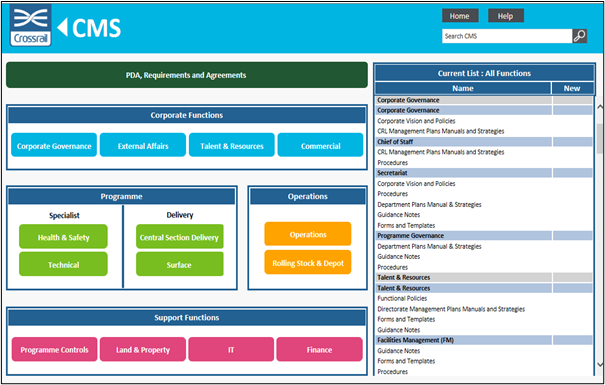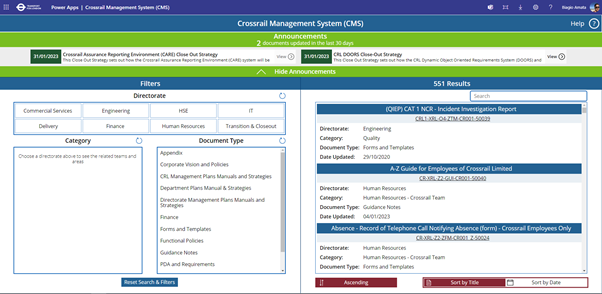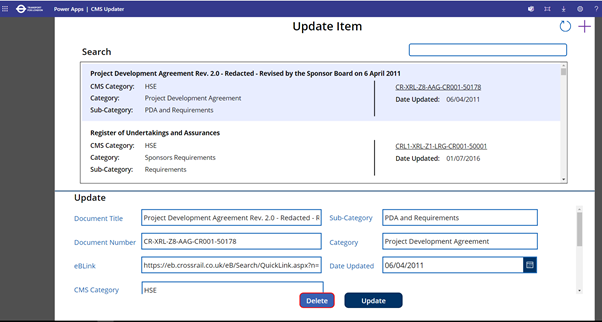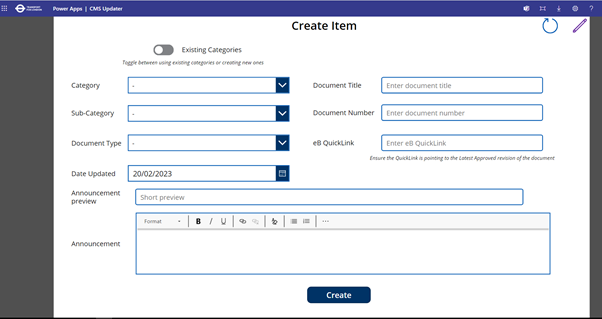
Crossrail Management System – 2023 Addendum
Document
type: Technical Paper
Author:
Aram Stirzaker, Biagio Amata
Publication
Date: 18/05/2023
-
Abstract
This paper is an addendum to the original Crossrail Management System Learning Legacy paper (April 2017) which examined Crossrail’s concept of establishing and implementing a management system that ensured key processes were mapped, describing the approach taken and outlining how the management system was developed. It also discussed the challenges encountered throughout the lifecycle of the Programme and how best practice and lessons learned were implemented.
The CMS in place during April 2017 employed a web portal to access the latest management system documents. In early 2019 an online system was developed to utilise a SharePoint portal to access the documents which were still held in the electronic document management system – eB.
This paper examines key developments within Crossrail that necessitated change to the management system, its structure and operation.
The document will be of interest to other major projects and any project professionals looking to set up an organisation wide management system
-
Read the full document
1 Introduction
The original CMS case study published in April 2017 explained that the Crossrail Management System (CMS) was designed to set out and mandate the processes and procedures that were adopted at a corporate level and for the delivery of the Crossrail Programme. In doing so it provided assurance to Sponsors (through the Project Representative), the Notified Body (NoBo) and Infrastructure Managers that the programme was being delivered coherently and correctly.
The CMS was initially developed to be an easy-to-use online system, utilizing a web portal to access the current management system documents. It was anticipated that the management system would evolve continuously in line with the advancing programme and any new organisation changes.
After initial development to meet the requirements of BS EN ISO 9001 (Quality)[1], BS EN ISO 14001 (Environment)[2] and BS OHSAS 18001 (Occupational Health and Safety)[3], from September 2018 the management system was certified only to meet the requirements of BS EN ISO 9001 (Quality)[1].
This case study examines key developments within Crossrail that necessitated change to the management system, its structure and operation.
2 Key developments that dictated change
There are several key inputs that Crossrail is required to comply with (Reference CMS Case Study 2017)[4]. These are:
- The Crossrail Act – 2008
- The Project Development Agreement (PDA)[5]
- The Sponsors Requirements
- Existing rail industry duty holder’s requirements
- The agreements between CRL and its Industry Partners
Although there were no changes to the key inputs listed above that Crossrail was required to comply with, there were other changes that needed consideration to keep the CMS current. These are examined in the following sections.
2.1 Requirements to standards
As noted in the introduction, the management system was developed to meet the requirements of BS EN ISO 9001 (Quality)[1], BS EN ISO 14001 (Environment)[2] and BS OHSAS 18001 (Occupational Health and Safety)[3]. As part of the certification these were independently checked by an external body (Lloyds Register Quality Assurance).
From September 2018 however the management system was certified to only meet the requirements of BS EN ISO 9001 (Quality)[1]. The reason for this being that each of these standards had been updated since Crossrail had their previous re-certification visit in June 2015. In the subsequent recertification visit in September 2018 certification was recommended only to BS EN ISO 9001 (Quality)[1] which had been updated in 2015.
The decision made by top management to maintain certification to the Quality standard helped maintain the profile of Quality within Crossrail and enabled development to the CMS to continue to be a priority. Achieving certification was also key to adding weight to the Crossrail Assurance Case.
2.2 Revised Opening Strategy
It was intended that the April 2016 version of the Delivery Strategy (Revision 9)[6] would be the final version in advance of Stage 3 opening (Paddington to Abbey Wood) in December 2018. However, following the announcement of the delay to opening in 2018, the Earliest Opening Programme (EOP) was introduced.
The revised opening strategy was implemented to allow opening of the Central Operating Section (COS) of the Elizabeth line (i.e. Stage 3 opening) at the earliest date possible and to support subsequent staged opening of the end-to-end railway (through Stage 4 and 5) as soon as possible afterwards.
The COVID-19 Recovery Execution Plan[7] that was developed in response to the pandemic led to the development of a Delivery Control Schedule[8] (Baseline DCS1.1) that would align with the overarching strategy set out in the EOP.
Both these developments were captured in the subsequent revision of the Delivery Strategy, Revision 10 (January 2021)[9] in addition to the significant change to the operating model and governance arrangements to reflect the transition to TfL. All of these developments had an impact on the CMS.
As Crossrail approached revenue service, the organisational structure needed to evolve to provide a lean and effective delivery team that was to be reflected in the CMS.
The Transition and Close out Programme was established to demobilise Crossrail by the end of March 2022 and transfer a CRL close out team to the Elizabeth line Operations organisation.
The resulting distilled CRL organisation, including a rationalisation of associated governance, dictated a slimmed down management system.
These developments lead to significant changes within the CMS structuring and also provided the opportunity to conduct a number of CMS reviews at strategic stages in the programme.
2.3 Crossrail Operating Model
There were several changes to the organisation between 2019 and 2023, the most recent one is reflected in the latest and final iteration of the Crossrail CMS (See figure 3). Under the leadership of the Close Out Director, in January 2023 the Closeout Organisation stood up, this comprised the programme team functions engaged to facilitate successful delivery and close-out of the Crossrail Programme. These were:
- Station close-out (including Elizabeth line Close-out Programme (ELCP), formerly LUCT Delivery)
- Routeway delivery
- Commercial services (including Legal, Agreements and U&As close-out)
- CRL Engineering close-out
- Health, Safety & Environment
- Transition & Close-out
- Programme Delivery Assurance
- Human Resources
- Finance
- IT
2.4 Crossrail Integrated Assurance Framework
CRL implemented a ‘Three Lines of Defence’ Integrated Assurance Framework (3LoD IAF) to provide assurance to its Executive Group and Board (and latterly to the TfL Elizabeth line Delivery Group) that it could safely deliver the Crossrail Project on time and to budget.
This framework is further described in the Functional Strategy – Assurance[10] which provides an overview of the Project and Programme Assurance function in the context of the 3LoD IAF framework including accountabilities, activities, interfaces and outputs.
This was in response to the Sponsors general requirement for programme assurance in the Project Development Agreement (PDA)[5] and in particular to recommendations from the Sponsors’ Governance Review of December 2018.
The framework was originally introduced in February 2019 and has been amended following changes to the corporate governance, bringing CRL under TfL governance arrangements (November 2021).
The Assurance Framework does not encompass external audit and assurance functions but does interface and coordinate with these bodies where they engage with the Elizabeth line.
The 3LoD IAF provides integrity and compliance for programme delivery, each line of defence is independent, incrementally building assurance evidence.
The framework implementation was significant to the development of the CMS as it applied to all activities relating to the Elizabeth line Programme. This in turn provided assurance in line with the compliance requirements prescribed by the PDA[5] across all disciplines of the Crossrail Project including Quality, Health & Safety, Commercial, Technical Compliance and Regulatory, Cost, Finance, Programme Controls, Schedule, Legal Compliance, Environment, Sustainability and Consents, People and Organisation.
The framework is illustrated in figure 1 below and comprises the following elements:
- First Line (LoD 1) – Programme Delivery Controls covering both Crossrail and Rail for London (Elizabeth line) organisations. These functions are embedded into day-to-day management of the organisations each overseen by the relevant Director. This includes Crossrail processes.
- Second Line (LoD 2) – Project and Programme Assurance (PPA) coordinates and integrates across all of Crossrail’s and RfL (EL) assurance using a risk-based approach to assess and report on confidence in delivery, adequacy of assurance and potential threats (risks) to objectives.
- Third Line (LoD 3) – TfL Internal Audit and a subgroup of the Independent Investment Programme Advisory Group (IIPAG) provide an independent assessment of the overarching integrity and performance of Crossrail’s 3LoD IAF conducting independent risk-based internal audits and reviews as necessary.
Figure 1 – Three Lines of Defence’ Integrated Assurance Framework (3LoD IAF)
2.5 Change in CMS format
By early 2017 the CMS had been developed into an easy to use online system utilising a Web Portal to access the current approved strategies, policies, plans, processes, procedures, guidance notes, forms and templates held in the document management system (eB). This is shown in in Figure 2 below.
Figure 2 – CMS Web Portal February 2017
Following a period of uncertainty within the organisation due to system upgrades and organisational changes, the CMS underwent a complete transformation. The new system was developed to utilise a SharePoint portal to access the documents which were still held in the document management system (eB).
3 Current CMS SharePoint Portal
Organisational Configuration
The ‘new’ CMS was developed to reflect the updated organisation and utilised a SharePoint portal to access the documents which were held in the eB as before. With constructive feedback from users the IT Team were able to develop and improve the application and features to create a highly versatile tool for accessing management documents.
As organisational changes were introduced, they could be easily managed and updated via an ‘APP link’ function.
Other improvements to the system were as follows:
- provision of user/s announcements on documents that were updated in the last 30 days.
- more intuitive system.
- features that allowed several search methods:
- by selecting a recently updated document from the announcements.
- improved facility for searching using free text search.
- using directorate search for documents.
- ability to filter documents by Directorate, Category and Document Type.
Finding a document with associated templates was now clearer, simpler and faster for the user. Figure 3 below shows the ‘front end’ CMS as seen by the general user. This example is in line with the final organisation structure (January 2023) shown in section 2.3 of this document.
Figure 3 – Front End SharePoint portal – General user
Document amendments
These could be easily managed by accessing the ‘Back End’ via a ‘Power App’. Updates to text such as the title and number could be made along with other criteria e.g. CMS category, sub-category and date updated. It was also important to ensure that the link to the document within eB was always to the ‘latest approved document’ so the revision is always current. See figure 4 below:
Figure 4 – Back End: Amending an existing document – CMS Manager
New documents
These were added in a similar way through the ‘Back End’ via a ‘Power App’ with the addition also of an announcement with a preview or short description of the document to assist the viewer. See figure 5 below
Figure 5 – Back End: Adding a ‘new’ document to the CMS – CMS Manager
4 CMS Review Strategy
The CMS was developed to access the current approved versions of management system documents and for Crossrail to maintain its certification these were independently checked by an external body (Lloyds Register Quality Assurance).
In addition, the CMS was still regularly monitored on a periodic basis with new documents being introduced and updates carried out as necessary, this was included within periodic reporting.
A lesson learned from the early CMS system was the importance of carrying out regular structured and focussed management system reviews. An overview of these is given below with an approximate timeline.
CMS Reviews (2019/2020)
With a new CRL organisation in place from early 2019 a refresh of the current CMS was necessary to ensure that the Directorates had a suite of documents to deliver the programme.
During July 2019 (2019/20 Period 4) an exercise was undertaken to highlight the key documents that were essential to deliver a successful programme.
This focus was maintained and in March 2020 (2019-20 Period 13), 111 were identified as Programme / Safety Critical documents for review and update. As well as addressing the reviews for these documents a further 75 documents were removed from the CMS and made obsolete.
A Sponsor’s Review was carried out in July 2020 where new ‘critical’ processes / procedures were established that were not captured in the CMS. These were identified for development and update into the CMS.
At this stage, progress with the review cycle was assisted by implementing a workstream with focussed Sponsor meetings to drive progress. In addition, critical processes and procedures were identified and given priorities for development.
CMS Readiness for Trial Running (TR) and Trial Operations (TO) (Late 2021)
For transition to ROGS – All Directorates reviewed their CMS documents and 26 documents were identified as critical to update in advance of Trial Running. The updates were completed and the CMS was declared Trial Running Ready.
The programme was under transition to ROGS which was critical as RfLI documents were now being issued to Crossrail and also needed to be made available on the CMS.
By the end of March 2021 (2020-21 Period 13) there were 745 documents in the CMS. From these there were 429 plans, policies, processes and procedures, all subject to review and update where required.
CMS Readiness for Post Revenue Service Organisation (May 2022)
Further to the successful CMS Readiness for TR and TO exercises that were carried out in late 2021 a further review was planned for May 2022. This update was to review documentation readiness for the Post Revenue Service (PRS) Organisation.
Focus on closing down non-essential documents and to review / update only critical documents to reflect the PRS Organisation was key. This review was launched in May 2022 when the Directorates were issued with lists of their documents to identify where processes were:
- Code 1 – Critical and already fit for purpose
- Code 2 – Critical and need updating
- Code 3 – To be retired and closed down (if the activity/function is ending)
- Code 4 – To be ‘baton passed’ or transferred outside CRL (providing details, on agreement, of the receiving TfL department/organisation and when (e.g. assets team, audit function)
Close Out Organisation Review (November 2022)
As Crossrail moved into its final stages a final review of the CMS was launched to reflect the Close Out Organisation in place to complete the programme, this was stood up in January 2023.
For this review it was important to only consider critical processes / procedures for updating and focus on fit for purpose, retiring and closing down or baton passing as many documents as possible. A list of documents was circulated to process owners with a direction to mark the documents codes 1 to 4 as with the PRS Review above.
Further to the Close Out Organisation Review the total of CMS Documents was reduced from 841 to 587 (made up of: 298 – Forms & Templates; 289 – All other documents). In total 253 documents were removed from the CMS.
For this review 44 documents were identified as Code 2 – Critical and need updating – these were completed ahead of the target date where the Close Out Organisation stood up.
5 Conclusions
The CMS portal journey from an early Visio model, into a process model, an online web based application and finally a SharePoint Portal enabled the IT team to innovate and utilise technology with the evolution of the CMS. In doing so meticulous testing was carried out to ensure the CMS was healthy and reliable.
With a frequently changing organisation it was not always easy to gain insight to proposed changes meaning that sometimes the CMS structure lagged behind organisational change. This was addressed by improving communication channels between teams.
Interrogation of the document management system (eB) using the reporting function was invaluable with exporting lists of documents and highlighting any work order anomalies within the system. Improved automation would allow reporting to be better defined.
The original CMS Case Study 2017 [4] highlighted that the CMS had evolved into a robust and secure system that was user friendly, provided ease of access, and had excellent storage capabilities. Utilisation of an effective review, approval, revision process, regular management system reviews and annual surveillance by certification body (LRQA) greatly increased the confidence from stakeholders and helped to make the system even more efficient.
6 Lessons learned
The following lessons learned should be considered:
- When the management system is to be developed in line with an organisation, early sight of organisation charts is essential to clarify structure, build the system in a logical way and to ensure any changes are reflected at an early stage. This was not always easy to achieve with the Crossrail system.
- It is important to seek feedback from users to enable the developer, in the case of Crossrail this was the IT team, to design an effective, functional and ‘user friendly’ management system.
- Secure top management support with the process. This is particularly useful with the following:
- provision of resources (for drafting, reviewing documents, document control etc.)
- driving the review and approval process
- raising the profile of any management system issues for resolution
- supporting developments and initiatives
- A lesson learned from the early system in use was with the implementation of regular structured and focussed management system reviews. At Crossrail this was demonstrated with reviews taking place for readiness at the following stages: Trial Running, Trial Operations, Post Revenue Service Organisation and Close Out Organisation. By this method the management system could be kept ‘lean’ containing only current and relevant documents.
- To assist teams with the Close Out organisation review (November 2022) a preliminary assessment was made the Quality Team and by discipline leads for a large number of documents with a recommendation to Directorates suggesting which could be retired. This quickly injected momentum and greatly helped speed up the review.
- The appointment of document ‘champions’ with a responsibility to co-ordinate reviews within teams was a huge asset when a large number of documents was considered.
- Where an electronic system is used for storing documents (such as eB the Crossrail document management system) it is important to develop an effective and ‘user friendly’ interface and ensure that the system has provision for clearly defined reporting and data export functionality.
7 References
[1] British Standard BS EN ISO 9001:2015 Quality management systems – Requirements.
[2] British Standard BS EN ISO 14001:2004/Cor 1:2009. Environmental management systems – Requirements. International Standards Organisation; 2009.
Replaced by – BS EN ISO 14001:2015 (Environmental management systems – Requirements with guidance for use)
[3] British Standard OHSAS 18001. Occupational Health and Safety Management (OHS). British Standards Institute; 2007.
Replaced by BS ISO 45001:2018 Occupational health and safety management systems. Requirements with guidance for use.
[4] CMS Case Study 2017 – Crossrail Learning Legacy
[5] CR-XRL-Z8-AAG-CR001-50178 Rev 3.0 Project Development Agreement (PDA)
[6] CR-XRL-Z-GST-CR001-00001 Rev 9.0 Delivery Strategy (April 2016)
[7] CRL1-XRL-Z-STP-CR001-50038 Rev 2.0 COVID-19 Recovery Execution Plan
[8] CRL1-XRL-Z9-TSC-CR001-50003 Rev 1.1 Delivery Control Schedule (Baseline DCS1.1)
[9] CR-XRL-Z-GST-CR001-00001 Rev 10 Delivery Strategy (January 2021)
[10] CRL1-XRL-O7-STP-CR001-50011 Rev 4.0 Functional Strategy – Assurance
Permission to reproduce extracts from British Standards is granted by BSI Standards Limited (BSI). No other use of this material is permitted. British Standards can be obtained in PDF or hard copy formats from the BSI (www.bsigroup.com)
-
Document Links
-
Authors
Aram Stirzaker - Crossrail Ltd
Aram Stirzaker was the Programme Quality Manager at Crossrail. He was responsible for the development of all Crossrail quality management systems, providing technical support and conducting Contractor Performance Assurance Assessments. He was also involved in initiatives such as World Quality Week and had a key role with developing reporting metrics and keeping the KPIs current. He has experience driving the completion process and was the Interim Completion Manager for 18 months. Gaining experience within the CRL Design Phase he worked as a Gates Co-ordinator for 4 years before joining the CRL Quality Team.
Aram started his career as an Engineer on the Channel Tunnel Rail Link and progressed into Quality Management. He now has almost 30 years experience, working with both client and contractor, principally on major infrastructure projects within the UK including HS1, Jubilee Line Extension, A35 Bypass and Heathrow Express. He was with Crossrail from January 2014 to May 2023.
Biagio Amata - Crossrail Ltd
Biagio was the Quality Compliance and Systems Manager at Crossrail. He was on the programme for 10 years from December 2012 to March 2023. He was responsible for the management of the Crossrail Management System (CMS), the weekly reporting on the status of Requests for Information (RFIs), Non-Conformance Reports (NCRs) and Field Change Documents (FCDs), as well as various ad-hoc analysis and reports for the business. He also ensured that the team had the support they need on a day-to-day basis, championing and coordinating events such as Contractor Performance Assurance Assessments, World Quality Week and the management of Spot-On Training maintaining a strong focus on continual improvement.
Biagio’s career covers over 20 years of experience, before joining Crossrail he worked within retail, e-commerce, recruitment and construction. Initially providing support to executives and the internal and external teams for companies such as lastminute.com, Arcadia, ASB NZ and Vodafone
-
Acknowledgements
Chris Titterton, Crossrail, Paper review and support
Susanne Barber, Crossrail, Paper review







